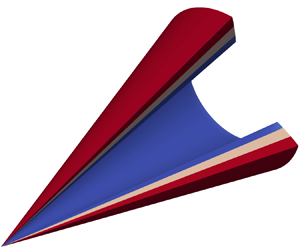No CrossRef data available.
Article contents
Basic solutions to Taylor–Maccoll equations
Published online by Cambridge University Press: 14 November 2024
Abstract

The Taylor–Maccoll (T–M) equations are the governing equations for steady inviscid irrotational axisymmetric conical flow, and have been widely applied to the design of waveriders and intakes. However, only four classic solutions have been reported: external conical flow (ECF), Busemann flow and internal conical flow of types A and B (ICFA and ICFB). In this work, the analysis of the T–M equations clarifies all possible solutions and reveals their relations. The domain where elementary solutions exist is divided into four domains. The classic Busemann and ICFB solutions share the same elementary solution as the template in a domain called the pre-shock domain, while the classic ECF and ICFA solutions belong to a domain named the ECF domain. Two new solutions, the inner flow of ECF (IECF) and degenerate conical flow (DCF), are found in the domains named after the corresponding solutions, namely the IECF and DCF domains. The IECF behaves as the mass injection supporting the classic ECF on an imaginary cone surface, while the DCF behaves as the conical expansion of a uniform flow. Furthermore, possible combinations of pre-shock solutions and supersonic post-shock solutions are clarified. The classic solutions are special cases where the pre-/post-shock solutions are combined with uniform flows. In general, the Busemann and ICFB solutions can be combined with any post-shock solutions in accord with the shock relations, including the ECF, ICFA, IECF and DCF solutions. In addition, numerical analyses are conducted to verify the validity of the two new solutions, DCF, IECF and one combined solution Busemann–ECF.
JFM classification
- Type
- JFM Papers
- Information
- Copyright
- © The Author(s), 2024. Published by Cambridge University Press



